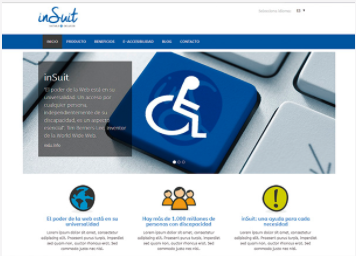

When discussing the benefits of web accessibility in business, we must consider the dynamic digital landscape emerging in 2025. Digital accessibility has evolved from a simple technical consideration to a decisive factor for business success.
With the European Accessibility Act coming into force on June 28, 2025, the benefits of web accessibility now go beyond mere regulatory compliance to become a strategic competitive advantage that drives growth, profitability, and business sustainability.
Organizations that embrace digital accessibility not only meet their legal responsibilities but also unlock a universe of untapped business opportunities.
According to current data, there is a potential market of more than 1.3 billion people with a purchasing power that significantly exceeds traditional expectations, a niche that, until now, has been largely overlooked.
This includes the community of people with disabilities, older adults, users with temporary limitations, or those with limited digital skills.
The New Digital Landscape: Business Opportunity and Legal Obligation
The Evolution of Regulation in 2025
The business landscape is undergoing an unprecedented transformation with the full implementation of the European Accessibility Act.
This legislation marks a turning point: companies that once considered accessibility optional now face a reality in which its implementation is both mandatory and strategically advantageous.
The regulation directly impacts private companies that offer digital products and services to the public, including e-commerce, digital financial services, transportation and ticketing portals, and widely used digital platforms.
This expansion of regulatory scope, from the public sector to the private, represents a democratization of accessibility that benefits both users and businesses.
The Critical State of Current Accessibility
Paradoxically, today’s reality presents a unique opportunity for forward-thinking companies. The 2025 WebAIM Million report found over 50 million accessibility errors on the one million most-visited web pages, averaging 51 errors per page.
While this reflects a 10.3% improvement over last year, 94.8% of the world’s top web pages still present detectable accessibility issues.
This gap between regulatory demand and market reality creates an extraordinary window of opportunity for companies that comply, positioning them as leaders in a market that rewards inclusive innovation.
Strategic Benefits That Transform Business
Exponential Expansion of the Target Market
The benefits of web accessibility begin with radically expanding the target market. In Spain, more than 4 million people live with some form of disability, but the beneficiaries of accessibility go far beyond this specific segment.
As mentioned earlier, this expanded inclusivity can significantly increase the potential customer base. Companies that implement accessibility best practices see substantial performance improvements, with revenue increases of up to 28% and profit margin boosts of up to 30%.
In the e-commerce sector, conversion rates can rise by as much as 15% when websites meet accessibility guidelines.
Success Stories That Demonstrate ROI
Real-world cases of successful web accessibility implementation provide tangible evidence of its positive impact on business results.
For example, UK financial services company Legal & General Group saw a 25% increase in organic search traffic within the first 24 hours after implementing accessibility improvements in 2005, which later rose to 50%.
Additional benefits included a 75% reduction in page load times, annual website maintenance savings of £200,000, and a 100% return on investment within 12 months.
This example shows that investing in accessibility is not only socially responsible but also economically profitable.
The Imperative of Legal Compliance and Its Implications
An Ever-Evolving Regulatory Framework
Legal compliance for web accessibility has rapidly evolved from a recommendation to a strict obligation. In Europe, the regulatory framework is based on Directive (EU) 2016/2102 for the public sector and the recent European Accessibility Act for the private sector.
Penalties for non-compliance are substantial and scale according to the severity of the violation, ranging from €301 to €1,000,000.
A notable example is Vueling, fined €90,000 for failing to meet 70% of accessibility requirements, illustrating the real consequences of non-compliance.
Beyond financial penalties, non-compliance carries reputational damage, exclusion from public procurement processes, loss of credibility in a market increasingly sensitive to corporate social responsibility, and a ban on access to public aid for periods of six months to two years.
Technological Trends Redefining Business Accessibility
inSuit 360™: The All-in-One Platform That Maximizes Results
inSuit 360™ stands out as the most comprehensive platform for turning digital accessibility into a growth engine.
Recognized with the Queen Letizia Award for Accessibility Technologies and featured by Gartner® in its Market Guide for Digital Accessibility, it offers an AI-powered ecosystem that ensures digital accessibility and regulatory compliance through powerful technological tools and 360° services provided by a team of certified consultants and technicians.
Key Modules of the inSuit 360™ Platform:
- inSuit Services™: Managed accessibility services provided by a team of experts ensuring compliance with current regulations.
- SIA® (Comprehensive Digital Accessibility Service): Included within inSuit Services™, this modular, adaptive solution guides organizations from initial development to achieving accessibility certification.
- inSuit Compliance™: Centralized platform for managing legal compliance in digital accessibility.
- inSuit Tools™: Enables accessible navigation for all users without altering the website’s source code.
- inSuit Accessibility Manager™: Instantly fixes web accessibility issues without touching the source code. Adjustments are manually applied by experts after an initial audit, supported by AI-based technologies, and can be deployed independently or alongside inSuit Tools™.
- inSuit PREP for PDF™: Smart solution for fixing and adapting PDF documents to make them accessible.
- inSuit Monitor™: Automated system that tracks and analyzes the technical state of digital accessibility.
- inSuit Remedy™: Provides smart, instant recommendations to fix accessibility errors. Based on inSuit Monitor™’s automatic analysis, its AI system proposes precise, tailored solutions that can be applied directly from inSuit Accessibility Manager™, ensuring ongoing, effective WCAG-compliant corrections, even in live environments.
Reducing Operational and Maintenance Costs
Integrating accessibility from the early stages of development is significantly more cost-effective than retrofitting later.
A Forrester study commissioned by Microsoft concluded that accessibility can reduce costs when integrated into existing development cycles.
Updates that include accessibility alongside other best practices require fewer maintenance resources and generate long-term operational savings.
This optimization also frees up budget for innovation and growth, creating a virtuous cycle of continuous improvement. Businesses report 25–40% reductions in web maintenance costs after implementing systematic accessibility practices.
Leading Position in a Transforming Market
Companies meeting the mandatory 2025 requirements gain multiple, lasting competitive advantages. In a market where most websites still fail to meet accessibility standards, being an early adopter brings immediate differentiation, brand credibility, and a favorable position for future business opportunities.
This leadership position translates into greater consumer trust, stronger stakeholder relationships, preferential access to regulated markets, and recognition as a socially responsible business.
Visionary organizations understand that accessibility is not just about compliance, it’s a strategic investment in future competitiveness and business sustainability.
The question is no longer whether to implement accessibility, but: How quickly can your organization turn this obligation into a sustainable competitive advantage?
If you want to discover how we can add value to your organization, contact us today. We are ready to provide all the information you need and support you in implementing an accessible solution aligned with regulations.
